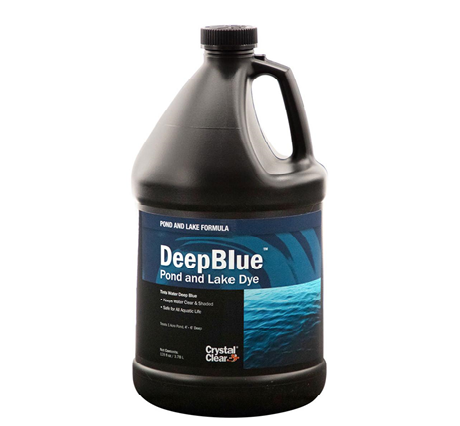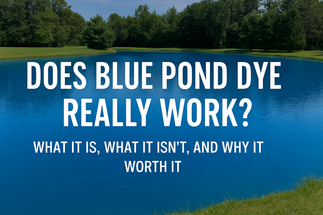Posted by Blue Thumb on Jun 17th 2025
Does Blue Pond Dye Really Work? What It Is, What It Isn’t, and Why It’s Worth It
If you’ve ever driven past a pond and noticed it looked unusually vibrant—almost like a perfectly Photoshopped shade of blue—it wasn’t a trick of the light. That pond was likely treated with blue pond dye. But does it actually do anything beyond making water look prettier? Spoiler: yes, and then some.
In this blog, we’ll break down what blue pond dye really is, clear up a few common myths, and explain why this unassuming product deserves a spot in your seasonal maintenance plan. Whether you manage a large subdivision pond or just want your backyard feature to stay clean and healthy, this one’s worth a closer look.
What Is Blue Pond Dye and Why Do People Use It?
Blue pond dye is one of those products that seems too simple to be effective—but it’s also one of the smartest additions you can make to your pond maintenance routine. At a glance, it turns your water a clean, rich sapphire tone. But functionally? It plays a critical role in pond care by limiting how much sunlight penetrates the water’s surface.
Too much sunlight is one of the main culprits behind algae overgrowth. According to NC State Extension, excess light availability fuels algae and plankton blooms, especially during warmer months. The more sun exposure, the more aggressive the photosynthetic process becomes—resulting in rapid algae accumulation that can make your pond look and smell awful.
That’s where blue pond dye comes in. It acts as a natural sunscreen for your pond. The dye shades the water column, reducing the amount of light that reaches algae spores at the bottom, effectively suppressing their growth before it starts. It doesn’t act like a chemical treatment—it’s more like putting on sunglasses for your pond.
Myth-Busting: Blue Dye Doesn’t Kill Algae—And That’s the Point
Let’s get this out of the way: blue pond dye is not a pesticide. It won’t eliminate existing algae blooms, and that’s exactly how it’s supposed to work.
The goal here isn’t to destroy the ecosystem; it’s to manage it proactively. Excess nutrients (from fertilizers, runoff, and fish waste) can lead to a process called eutrophication, where rapid algae growth depletes oxygen and disrupts aquatic life. According to the NOAA, eutrophication is a major driver of harmful algal blooms, which can kill fish and create hypoxic “dead zones.”
Now here’s the kicker—light is a key ingredient in that runaway cycle. Without sufficient light, algae can’t photosynthesize at damaging rates. This is where pond dye excels. It doesn’t treat the symptoms like a chemical algaecide. Instead, it reduces the conditions that allow algae to thrive in the first place.
Scientific studies back this approach: when light limitation strategies are employed, algal growth slows dramatically, especially in nutrient-rich environments. Think of blue pond dye as part of a preventative strategy—it keeps algae from winning the race in the first place.

How Blue Dye Supports a Healthier Pond Ecosystem
When applied correctly, pond dye like our Deep Blue Pond Dye does more than just cut back sunlight. It helps your pond maintain a better balance overall.
Reduced sunlight means less temperature fluctuation. That’s a win for fish, plants, and beneficial bacteria, which can suffer when water temperatures spike. Blue pond dye creates a thermally stable environment that supports a range of aquatic life, especially when paired with aeration systems that keep oxygen levels consistent.
And here’s the thing—we always recommend using our dye in tandem with other natural treatments like beneficial bacteria and enzymes. While the dye controls sunlight, these biological tools help break down excess nutrients, keeping muck and sludge under control. It’s about teamwork: our dye lays the foundation, and your aeration and bio-treatments build on it.
Enhancing Pond Aesthetics Without Risking Fish or Plants
You can’t overlook the cosmetic appeal. Our True Blue Pond Dye Packets instantly transform dull, greenish water into a brilliant shade of clean, cobalt blue. Your pond looks deeper, cooler, and—yes—healthier.
But more importantly, we’ve formulated these products to be safe. That includes fish, frogs, birds, pets, and even your aquatic plants. When used as directed, ClearLake True Blue Dye is non-toxic and non-staining. We’ve had customers use it in backyard koi ponds and subdivision water features without a hitch.
It’s also mess-free. Our packets are water-soluble and pre-measured, so there’s no need for gloves or guesswork. Just toss one in and let the color naturally disperse.
When and How to Apply Blue Pond Dye for Best Results
Timing and dosage matter—and we’ve made both easy to handle.
Start early. We usually recommend adding blue pond dye in early spring, before algae has a chance to get ahead of you. This proactive step shades the water before the warm season intensifies, which is when sunlight and nutrient buildup tend to combine and trigger blooms.
To figure out how much to use, check your pond’s surface area and average depth. Our Blue Pond Dye 16oz bottle treats up to one acre of water at 4 feet deep. If your pond is smaller or shallower, just adjust accordingly. And don’t worry about precise measurements—our formula disperses evenly for a long-lasting effect.
Wondering how long it lasts? A single application can provide coverage for up to 30 days depending on rainfall, runoff, and sunlight exposure. And yes—it’s safe to swim or fish after application. We suggest waiting 24 hours just to allow the dye to settle uniformly.
Is Blue Pond Dye Worth It?
Let’s not overcomplicate this: blue pond dye isn’t some magic fix. It won’t solve all your pond problems, but it’s one of the smartest tools you can add to your toolbox.
Here’s what it gets right:
- It instantly improves water clarity and color.
- It reduces algae-fueling sunlight without harming the ecosystem.
- It’s compatible with biological additives like our Muck Buster Lake and Pond Cleaner Lake, making overall pond maintenance more effective.
- It helps regulate water temperature, keeping conditions ideal for fish and plants.
- It’s simple to apply, long-lasting, and affordable.
Real talk? You’ll still need to pay attention to nutrient control, aeration, and seasonal upkeep. But pond dye buys you time. It gives your treatments the upper hand—and your pond, a healthy glow.
So, does blue pond dye really work? Absolutely. Not because it’s flashy, but because it’s smart science and strategic prevention packed into a bottle of beautiful blue.
Ready to make your pond look better and function better? Explore our complete line of Blue Thumb Water Treatments—because prevention is always easier than reaction.

